Scalable Recognition with a Vocabulary Tree
一个新标识英语作文带翻译
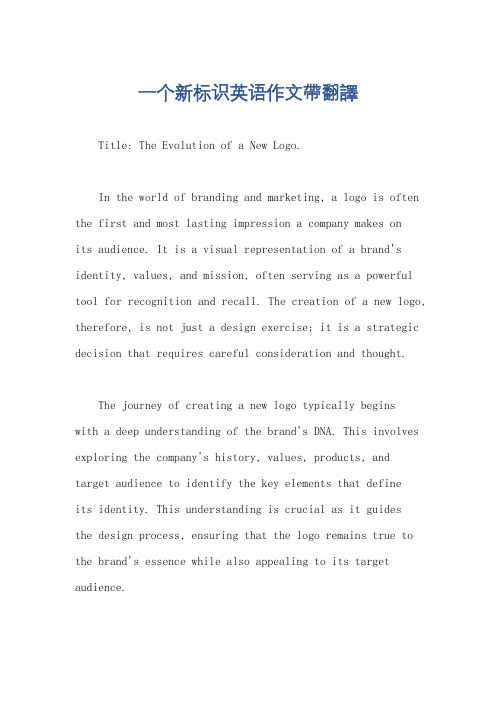
一个新标识英语作文帶翻譯Title: The Evolution of a New Logo.In the world of branding and marketing, a logo is often the first and most lasting impression a company makes onits audience. It is a visual representation of a brand's identity, values, and mission, often serving as a powerful tool for recognition and recall. The creation of a new logo, therefore, is not just a design exercise; it is a strategic decision that requires careful consideration and thought.The journey of creating a new logo typically beginswith a deep understanding of the brand's DNA. This involves exploring the company's history, values, products, andtarget audience to identify the key elements that defineits identity. This understanding is crucial as it guidesthe design process, ensuring that the logo remains true to the brand's essence while also appealing to its target audience.Once the brand's identity is clear, the design process can commence. This often involves several rounds of iterations and refinements, as designers experiment with different shapes, colors, fonts, and arrangements to find the perfect combination that represents the brand effectively. It is important to note that a logo should not only be visually appealing but also functional, readable, and scalable across various mediums and sizes.During the design process, it is also crucial to consider the logo's adaptability and timelessness. A good logo should be able to withstand the test of time, staying relevant and recognizable even as trends and fashions change. This means avoiding trends and fads that may become outdated quickly, instead focusing on creating a timeless design that will stand the test of time.Once a final design is chosen, it is essential to test it in various contexts to ensure its effectiveness. This may involve testing it on different backgrounds, media, and sizes to ensure it maintains its visual impact and readability. Additionally, it is important to test thelogo's recognition and recall among the target audience to ensure it is effective in representing the brand and communicating its values.The launch of a new logo is not just the culmination of a design process; it is the beginning of a new chapter for a brand. It signals a fresh start, a renewed commitment to values, and a refreshed identity that resonates with its audience. As such, the launch should be carefully planned and executed to maximize its impact. This may involve a phased approach, gradually introducing the new logo across various touchpoints to build anticipation and excitement.In conclusion, the creation of a new logo is a complex and iterative process that requires a deep understanding of a brand's identity, careful consideration of design elements, and thorough testing to ensure its effectiveness. It is a journey that, when done well, results in a powerful visual asset that represents a brand's values, mission, and promise to its audience.[翻译]标题,新标识的演变。
英语词汇测评
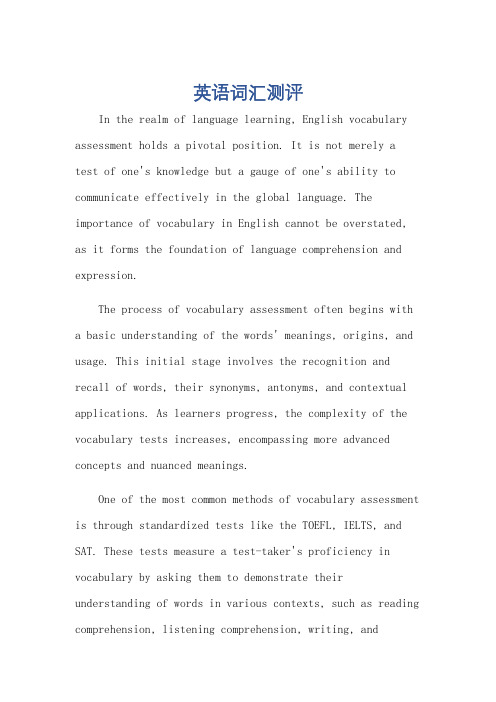
英语词汇测评In the realm of language learning, English vocabulary assessment holds a pivotal position. It is not merely atest of one's knowledge but a gauge of one's ability to communicate effectively in the global language. The importance of vocabulary in English cannot be overstated, as it forms the foundation of language comprehension and expression.The process of vocabulary assessment often begins with a basic understanding of the words' meanings, origins, and usage. This initial stage involves the recognition and recall of words, their synonyms, antonyms, and contextual applications. As learners progress, the complexity of the vocabulary tests increases, encompassing more advanced concepts and nuanced meanings.One of the most common methods of vocabulary assessment is through standardized tests like the TOEFL, IELTS, and SAT. These tests measure a test-taker's proficiency in vocabulary by asking them to demonstrate their understanding of words in various contexts, such as reading comprehension, listening comprehension, writing, andspeaking. The scores obtained from these tests are often used as a benchmark for academic and professional advancement.However, vocabulary assessment isn't limited to formal testing. Informal assessments, such as self-quizzes, word games, and conversational exchanges, can also be effectivein evaluating one's vocabulary skills. These activities provide a more relaxed and engaging environment forlearning and practicing new words.The benefits of vocabulary assessment are numerous. Firstly, it enhances language comprehension, allowing learners to better understand and interpret written and spoken English. Secondly, it improves language production, enabling learners to express themselves more accurately and eloquently. Finally, it fosters cultural awareness,exposing learners to a wider range of vocabulary related to different cultures and contexts.In conclusion, English vocabulary assessment is acrucial aspect of language learning. It not only评估一个人的语言知识,but also评估他们的沟通能力、思维能力和文化素养。
冀教版八年级英语Lesson
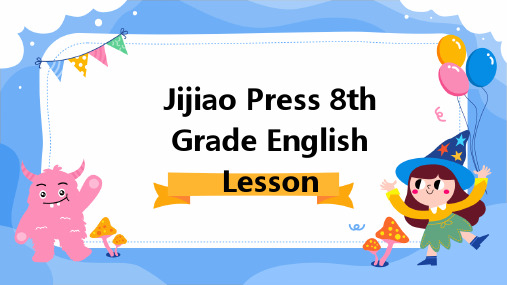
01
Course Introduction
Course objectives
01
Develop students' English listening, speaking, reading and writing skills
02
Improve students' ability to understand and use English grammar and vocabulary
04
Reading comprehension
Reading skill
• Predicting: Predicting what will happen in a story based on the information given This helps students to engage more actively with the text and understand the plot better
with a variety of activities including listening exercises, speaking drills, reading comprehension tasks, writing assignments, group discussions and role plays • Regular assessments and exams are conducted to monitor students' progress and provide feedback for further improvement
voice and its usage in different contexts
Vocabulary Tree

Scalable Recognition with a Vocabulary Tree
K-d Tree & BBF (Best bin first)
K-d Tree
• 实际上是一棵平衡二叉树
– 例: pointList = [(2,3), (5,4), (9,6), (4,7), (8,1), (7,2)] tree = kdtree(pointList)
概念:
• k-d树是一个特殊的二叉树,每个非叶节点 对应一个k维的向量点。这个节点表示一个 垂直于某维轴的超平面,将空间一分为二。 这个节点所有左子树上的点都在这个超平 面左边,所有右子树上的点都在这个超平 面的右边。
k-d树的构建的经典方法
• 每个坐标轴被依次循环使用,来选择分割 超平面; • 分割位置被选择在所有剩下点的该坐标的 中点; • 所生成的k-d树是一个平衡二叉树。其中每 个叶子和根节点的距离基本相等。
Scalable Recognition with a Vocabulary Tree
Scalable Recognition with a Vocabulary Tree
Scalable Recognition with a Vocabulary Tree
Scalable Recognition with a Vocabulary Tree
最近邻搜索算法
• 按照插入节点的方法遍历树,找到一个叶 子节点; • 将此叶子节点记作当前最好点; • 反溯而上,如果父节点比当前最好点还要 好,则检查其左右子树。
改善方法•ຫໍສະໝຸດ 限定查找的点数 • 限定查找时间 • 或者采用近似最邻近搜索算法,例如: Best Bin First。
缺点
Second Language Vocabulary Acquisition
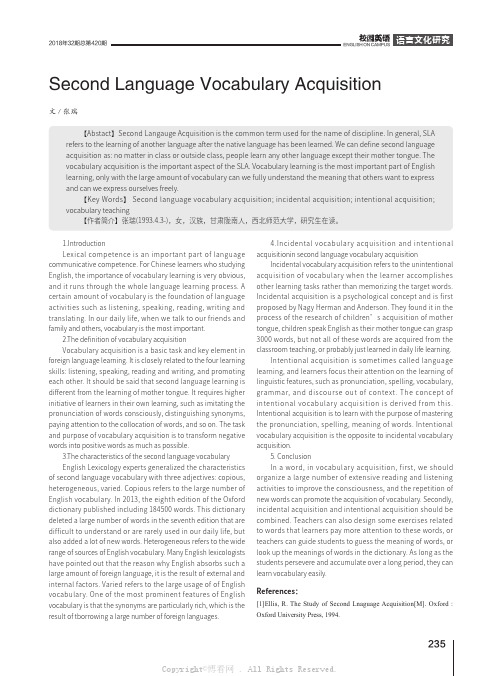
2352018年32期总第420期ENGLISH ON CAMPUSSecond Language Vocabulary Acquisition文/张瑞【Abstact】Second Langauge Acquisition is the common term used for the name of discipline. In general, SLA refers to the learning of another language after the native language has been learned. We can define second language acquisition as: no matter in class or outside class, people learn any other language except their mother tongue. The vocabulary acquisition is the important aspect of the SLA. Vocabulary learning is the most important part of Englishlearning, only with the large amount of vocabulary can we fully understand the meaning that others want to express and can we express ourselves freely. 【Key Words】 Second language vocabulary acquisition; incidental acquisition; intentional acquisition; vocabulary teaching 【作者简介】张瑞(1993.4.3-),女,汉族,甘肃陇南人,西北师范大学,研究生在读。
小学英语第三课练习字母

Introduce the phonetic sounds associated with each letter, focusing on the relationship between letters and sounds.al Practice: Reading and Dialogue
Read the text aloud and cultivate language sense
Writing skills
Students will practice writing the letters of the alphabet correctly, with proper formation and stroke order.
Vocabulary building
Through the use of example words and sentences, students will learn to associate letters with sounds and begin to build their vocabulary.
Distinguish between similar sStouduenntsdwsill practice
differentiating between words that sound similar but have different meanings, such as "their" and "there."
differentiate between short and long vowel sounds by listening to the recording and identifying the distinct pronunciations.
王老师英语单词知识点总结

王老师英语单词知识点总结Importance of Vocabulary AcquisitionVocabulary acquisition is a fundamental aspect of language learning. Without a good grasp of vocabulary, it is difficult for students to understand and communicate effectively in a new language. English has a rich and diverse vocabulary, with over a million words, making it essential for students to continually expand their word knowledge. Research has shown that vocabulary knowledge is strongly correlated with reading comprehension, writing ability, and overall language proficiency.It is important for teachers to recognize the significance of vocabulary acquisition and to prioritize it in their language teaching. By helping students to build a strong foundation of English words, teachers can support their language development in all areas, from speaking and listening to reading and writing.Strategies for Teaching VocabularyThere are several different strategies that teachers can use to teach English vocabulary effectively. One common approach is to use the direct method, where teachers explicitly introduce new words and their meanings to students. This may involve providing definitions, examples, and usage in context. It is important to make sure that students understand the meaning and usage of the words before moving on to the next set of vocabulary.Another effective strategy is to use context to teach vocabulary. This involves presenting new words in meaningful contexts, such as in a reading passage or a dialogue, so that students can understand how the word is used in real-life situations. Contextual learning helps students to grasp the meaning of words and how they are used in different contexts. Teachers can also use mnemonic devices, such as word associations, pictures, or stories, to help students remember new words. By creating connections between new words and existing knowledge, students can retain vocabulary more effectively. Additionally, teachers can encourage students to use the new words in their speaking and writing, which reinforces their understanding and retention of the vocabulary.Role of Context in Understanding and Using WordsUnderstanding the role of context is crucial in language learning, especially when it comes to vocabulary. Context provides important clues for understanding the meaning and usage of words. When students encounter new words in meaningful contexts, they are better able to make inferences about the word's meaning and how it is used.Teachers should provide a variety of contexts for students to encounter and practice new words. This may include reading passages, listening activities, and real-life situations where students can use the words in context. By exposing students to a range of contexts, teacherscan help them to develop a deeper understanding of how words are used in different settings.Practical Tips for TeachersHere are some practical tips for teachers to help their students improve their English vocabulary:1. Integrate vocabulary instruction into all areas of language learning, including speaking, listening, reading, and writing.2. Use a variety of teaching strategies, such as the direct method, contextual learning, and mnemonic devices, to help students acquire and retain new words.3. Provide ample opportunities for students to practice using new words in context, such as through conversations, writing exercises, and real-life situations.4. Encourage students to engage with English outside of the classroom, such as by reading, watching English-language media, and using language learning apps.5. Regularly review and reinforce previously learned vocabulary to ensure retention and mastery.By following these tips, teachers can support their students in building a strong and extensive English vocabulary.ConclusionTeaching English vocabulary is a critical component of language instruction, and it requires careful consideration and thoughtful planning. By recognizing the importance of vocabulary acquisition, using effective teaching strategies, understanding the role of context in word understanding, and implementing practical tips for teaching vocabulary, teachers can help their students develop a strong and comprehensive grasp of English words.It is important for language teachers to be intentional in their vocabulary instruction and to create a supportive and engaging learning environment for students. By prioritizing vocabulary acquisition and providing ample opportunities for practice and reinforcement, teachers can help their students to become confident and proficient English language users.。
《高二英语词汇复习》课件

Memory methods for high school second year English vocabulary
Summary words
Classification memory method is a method of categorizing and organizing vocabulary according to characteristics such as theme, part of speech, and meaning.
Detailed description
Practice and consolidation of high school second year English vocabulary
Purpose
To help students consolidate their learned vocabulary and improve their ability to apply vocabulary.
01
02
Adverbs are words used to describe verbs, adjectives, or other adverbs, such as "quickly", "happy", "very", etc.
Adjectives are words used to describe the characteristics of nouns or pronouns, such as "big", "beautiful", "red", etc.
03
Having sufficient English vocabulary can increase students' opportunities to choose majors and schools, preparing them for their future careers.
英语作文总结词汇
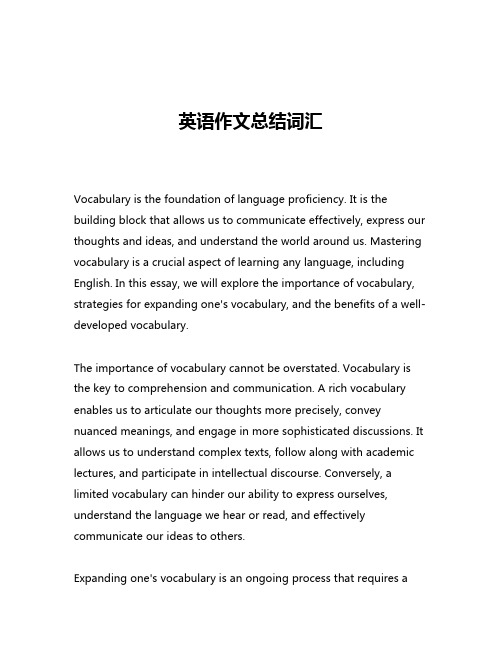
英语作文总结词汇Vocabulary is the foundation of language proficiency. It is the building block that allows us to communicate effectively, express our thoughts and ideas, and understand the world around us. Mastering vocabulary is a crucial aspect of learning any language, including English. In this essay, we will explore the importance of vocabulary, strategies for expanding one's vocabulary, and the benefits of a well-developed vocabulary.The importance of vocabulary cannot be overstated. Vocabulary is the key to comprehension and communication. A rich vocabulary enables us to articulate our thoughts more precisely, convey nuanced meanings, and engage in more sophisticated discussions. It allows us to understand complex texts, follow along with academic lectures, and participate in intellectual discourse. Conversely, a limited vocabulary can hinder our ability to express ourselves, understand the language we hear or read, and effectively communicate our ideas to others.Expanding one's vocabulary is an ongoing process that requires amultifaceted approach. One of the most effective strategies is to read extensively. Reading a wide range of materials, from novels and newspapers to academic journals and technical documents, exposes us to a diverse array of vocabulary. As we encounter new words in context, we can infer their meanings and commit them to memory. Additionally, reading helps us develop a better understanding of word usage, collocations, and idiomatic expressions, which are essential for fluent language use.Another effective strategy is to actively engage with new vocabulary. This can be done through various methods, such as keeping a vocabulary journal, creating flashcards, or using language learning apps. By regularly reviewing and practicing new words, we can solidify their meanings and integrate them into our active vocabulary. Engaging in word games, such as crossword puzzles or Scrabble, can also be a fun and effective way to build vocabulary.Consistent exposure to and practice with new vocabulary is crucial for language learners. However, it is also important to understand the different types of vocabulary and how they are acquired. Receptive vocabulary refers to the words we can understand when we read or hear them, while productive vocabulary refers to the words we can actively use in our own speech and writing. Developing both receptive and productive vocabulary is essential for comprehensive language proficiency.The benefits of a well-developed vocabulary extend far beyond language learning. A robust vocabulary can enhance our cognitive abilities, improve academic and professional performance, and even contribute to personal growth. Studies have shown that individuals with a strong vocabulary tend to have better problem-solving skills, critical thinking abilities, and overall academic achievement. In the professional realm, a diverse vocabulary can be an asset, enabling us to communicate more effectively, write more persuasively, and engage in more nuanced discussions.Moreover, a rich vocabulary can also enrich our personal lives. It can allow us to express our emotions and experiences more accurately, engage in more meaningful conversations, and appreciate literature, poetry, and other forms of artistic expression more deeply. A well-developed vocabulary can also contribute to our sense of confidence and self-esteem, as we feel empowered to articulate our thoughts and ideas with clarity and precision.In conclusion, vocabulary is a fundamental aspect of language learning and proficiency. Expanding one's vocabulary requires a multifaceted approach, including extensive reading, active engagement with new words, and consistent practice. The benefits of a well-developed vocabulary are numerous, ranging from enhanced cognitive abilities and academic performance to improvedcommunication skills and personal growth. By prioritizing vocabulary development, language learners can unlock a world of opportunities and enrich their lives in meaningful ways.。
Unit2Theuniversallanguage词汇知识点清单-高中英语译林版(2020)选择性

1.music n.音乐musical adj.音乐的musician adj.音乐家2.pose v.作曲poser v.作曲家position n.作品3.please v.取悦pleased adj.开心的pleasant adj.令人愉悦的pleasure n.愉快,荣幸4.bine v.结合bination n.结合5.adapt v.适应;改编adaptation n.改编本;适应6.defend v.防御defence n.防御7.greet v. 打招呼greeting n.问候8.suit v.适合suitable adj.适合的9.distant adj.遥远的;冷淡的distance n.距离;疏远10.breath n.呼吸breathe v.呼吸11.pany n.陪伴acpany v.陪伴panion n.伴侣,伙伴12.expect v.期待expectation n.期待13.enthusiastic adj.热情的enthusiasm n.热情14.gift n.天赋gifted adj.有天赋的15.predict v.预测prediction n.预测16.depress v.使...沮丧/抑郁depression n. 沮丧,抑郁depressed adj.沮丧的depressing adj.使人沮丧的17.possess v.拥有possession n.拥有18.transform v.转变transformation v.转变19.explode v.爆炸explosion n.爆炸20.satisfy v.使满意satisfying/satisfactory adj.令人满意的satisfied v.满意的satisfaction n.满意21.recognize v.认出;意识到recognition n.认识;赞赏22.rely v.依赖,信赖reliable adj.值得信赖的23.surround v.包围surrounding adj.周围的surroundings n.环境24.determine v.决心,决定determination n.决心determined adj.坚定的25.admit v.承认;允许进入admission n.承认;准入进入;入场费三、固定短语1. a wide range of types 种类繁多2. a piece of music 一首音乐3. a live music performance 现场音乐演出4.deserve to be done 值得被...5.the twists and turns 曲折,跌宕起伏6.tear apart使(关系密切的人)分离,开7.weep bitterly over the loss of... 因失去...而痛哭8.be overe with sorrow悲痛欲绝9.have one`s roots in起源于10.rely on依赖,依靠;信任11.it turns out that... 原来,结果是...12.throw in sth额外赠送13.give the public more access to music 给大众更多接触音乐的机会14.put on a series of free concerts 举办一系列免费音乐会15.bine…and/with…把…和…结合起来16.the munist Party of China中国共产党17.overe the Japanese invaders战胜日本侵略者18.in particular 尤其,特别19.deserve a mention 值得一提20.end with以...结尾21.think highly of 高度评价22.get tired of 厌倦23.it`s no use doing做...是没有用的24.be capable of 能够25.get down to (doing) sth开始着手做...26.have trouble doing sth 做某事有困难27.every other week 每隔一周28.in a state of 处在…的状态中29.turn up the volume调高音量30.stare at 凝视,盯住31.hold one`s breath屏住呼吸32.uncover the beauty of the song 发现歌曲的美33.grab the attention of sb 抓住某人的注意力34.sweep along席卷,使深受影响35.at the top of my voice 用最大的声音36.reflect on 反思37.a crowd of 一群38.stream into涌入39.break into enthusiastic cheers爆发出热情的欢呼40.be unaware of未意识到,没察觉到41.a sea of people 一群人42.enjoy a reputation as… 享誉…的盛名43.take a sharp turn 急转弯44.be determined to do sth 决定做...45.all of a sudden 突然46.strong will 坚强的意志47.with ease 从容地,熟练地48.be regarded as 被看作…三、好句积累1.It’s a piece that really deserves to be heard.这部作品真的值得一听。
四级英语作文词汇要求
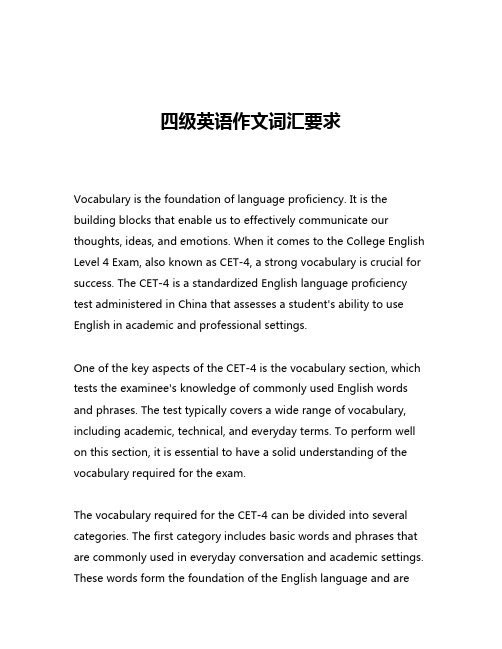
四级英语作文词汇要求Vocabulary is the foundation of language proficiency. It is the building blocks that enable us to effectively communicate our thoughts, ideas, and emotions. When it comes to the College English Level 4 Exam, also known as CET-4, a strong vocabulary is crucial for success. The CET-4 is a standardized English language proficiency test administered in China that assesses a student's ability to use English in academic and professional settings.One of the key aspects of the CET-4 is the vocabulary section, which tests the examinee's knowledge of commonly used English words and phrases. The test typically covers a wide range of vocabulary, including academic, technical, and everyday terms. To perform well on this section, it is essential to have a solid understanding of the vocabulary required for the exam.The vocabulary required for the CET-4 can be divided into several categories. The first category includes basic words and phrases that are commonly used in everyday conversation and academic settings. These words form the foundation of the English language and areessential for effective communication. Examples of such words include "the," "and," "to," "be," "have," and "do."The second category of vocabulary consists of more advanced academic and technical terms. These words are often used in scientific, literary, and professional contexts. They are essential for understanding and communicating complex ideas and concepts. Examples of such words include "hypothesis," "paradigm," "phenomenon," "metaphor," and "infrastructure."The third category of vocabulary includes idiomatic expressions and phrasal verbs. These are multi-word phrases that have a meaning that is different from the individual words that make them up. Idiomatic expressions and phrasal verbs are commonly used in both written and spoken English, and mastering them is crucial for achieving high scores on the CET-4. Examples of such phrases include "break the ice," "let the cat out of the bag," "look up to," and "put up with."In addition to these three main categories, the CET-4 also tests examinees' knowledge of prefixes, suffixes, and root words. Understanding the structure of words can help students decipher the meaning of unfamiliar terms and expand their vocabulary. For example, knowing that the prefix "re-" means "again" can help students understand the meaning of words like "redo," "rewrite," and"reconsider."To prepare for the vocabulary section of the CET-4, students should adopt a comprehensive and systematic approach. This includes regularly reading high-quality English materials, such as newspapers, magazines, and academic journals, to expose themselves to a wide range of vocabulary. Additionally, students should actively engage in vocabulary-building exercises, such as flashcards, word games, and online quizzes, to reinforce their understanding of the words and phrases required for the exam.Another effective strategy for improving vocabulary for the CET-4 is to focus on the most commonly used words and phrases. The Pareto principle, also known as the 80/20 rule, suggests that 80% of the results come from 20% of the input. In the context of vocabulary, this means that by mastering the most frequently used words and phrases, students can significantly improve their overall language proficiency and performance on the CET-4.Furthermore, students should pay attention to the context in which words are used and try to understand their nuanced meanings. This can help them avoid common mistakes, such as using a word incorrectly or confusing similar-sounding terms. Additionally, students should practice using the new vocabulary they have learned in their own writing and speaking, as this will help cement theirunderstanding and improve their overall language skills.In conclusion, the vocabulary required for the College English Level 4 Exam is a critical component of the test. By adopting a comprehensive and systematic approach to vocabulary building, students can improve their chances of success on the CET-4 and develop a strong foundation for their future academic and professional endeavors. Remember, mastering vocabulary is not just about passing an exam; it is a lifelong journey that can open up a world of opportunities and enrich your life in countless ways.。
一种基于词汇树结构的图像检索方法研究
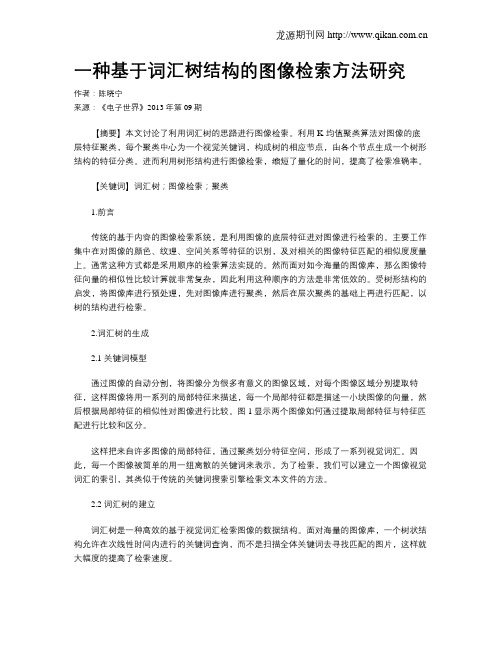
一种基于词汇树结构的图像检索方法研究作者:陈晓宁来源:《电子世界》2013年第09期【摘要】本文讨论了利用词汇树的思路进行图像检索。
利用K-均值聚类算法对图像的底层特征聚类,每个聚类中心为一个视觉关键词,构成树的相应节点,由各个节点生成一个树形结构的特征分类。
进而利用树形结构进行图像检索,缩短了量化的时间,提高了检索准确率。
【关键词】词汇树;图像检索;聚类1.前言传统的基于内容的图像检索系统,是利用图像的底层特征进对图像进行检索的。
主要工作集中在对图像的颜色、纹理、空间关系等特征的识别,及对相关的图像特征匹配的相似度度量上。
通常这种方式都是采用顺序的检索算法实现的。
然而面对如今海量的图像库,那么图像特征向量的相似性比较计算就非常复杂,因此利用这种顺序的方法是非常低效的。
受树形结构的启发,将图像库进行预处理,先对图像库进行聚类,然后在层次聚类的基础上再进行匹配,以树的结构进行检索。
2.词汇树的生成2.1 关键词模型通过图像的自动分割,将图像分为很多有意义的图像区域,对每个图像区域分别提取特征,这样图像将用一系列的局部特征来描述,每一个局部特征都是描述一小块图像的向量,然后根据局部特征的相似性对图像进行比较。
图1显示两个图像如何通过提取局部特征与特征匹配进行比较和区分。
这样把来自许多图像的局部特征,通过聚类划分特征空间,形成了一系列视觉词汇。
因此,每一个图像被简单的用一组离散的关键词来表示。
为了检索,我们可以建立一个图像视觉词汇的索引,其类似于传统的关键词搜索引擎检索文本文件的方法。
2.2 词汇树的建立词汇树是一种高效的基于视觉词汇检索图像的数据结构。
面对海量的图像库,一个树状结构允许在次线性时间内进行的关键词查询,而不是扫描全体关键词去寻找匹配的图片,这样就大幅度的提高了检索速度。
我们将训练样本图像输入,这样可以提取到大量的图像特征,词汇树学习使用分层k-均值法。
词汇树的形成需要控制两个参数:水平数量L指定的树的高度,分支因子B指定的子节点的数量。
四级英语作文词汇要求
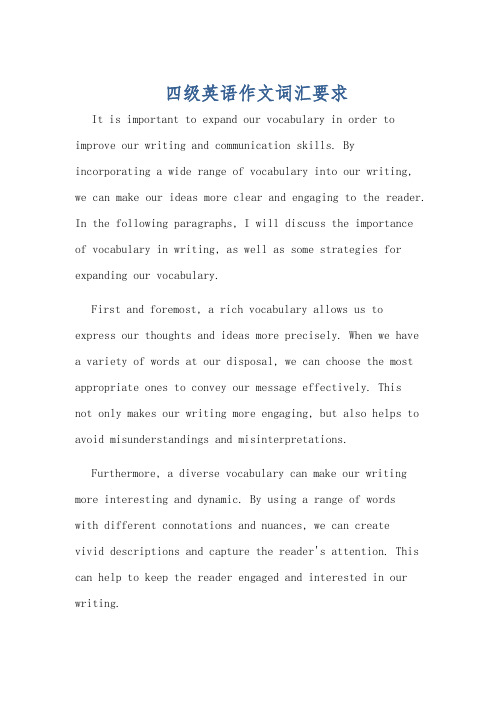
四级英语作文词汇要求It is important to expand our vocabulary in order to improve our writing and communication skills. By incorporating a wide range of vocabulary into our writing, we can make our ideas more clear and engaging to the reader. In the following paragraphs, I will discuss the importanceof vocabulary in writing, as well as some strategies for expanding our vocabulary.First and foremost, a rich vocabulary allows us to express our thoughts and ideas more precisely. When we have a variety of words at our disposal, we can choose the most appropriate ones to convey our message effectively. Thisnot only makes our writing more engaging, but also helps to avoid misunderstandings and misinterpretations.Furthermore, a diverse vocabulary can make our writing more interesting and dynamic. By using a range of wordswith different connotations and nuances, we can createvivid descriptions and capture the reader's attention. This can help to keep the reader engaged and interested in our writing.There are several strategies that can help us expand our vocabulary. One effective method is to read extensively in a variety of genres and styles. By exposing ourselves to different types of writing, we can encounter new words and expressions that we can incorporate into our own writing. Additionally, using a thesaurus can help us find synonyms and alternative words that can enrich our vocabulary.In conclusion, a strong vocabulary is essential for effective writing. By expanding our vocabulary and incorporating a variety of words into our writing, we can improve our communication skills and make our writing more engaging and impactful.扩展词汇对于提高写作和沟通能力至关重要。
介绍标识英语作文
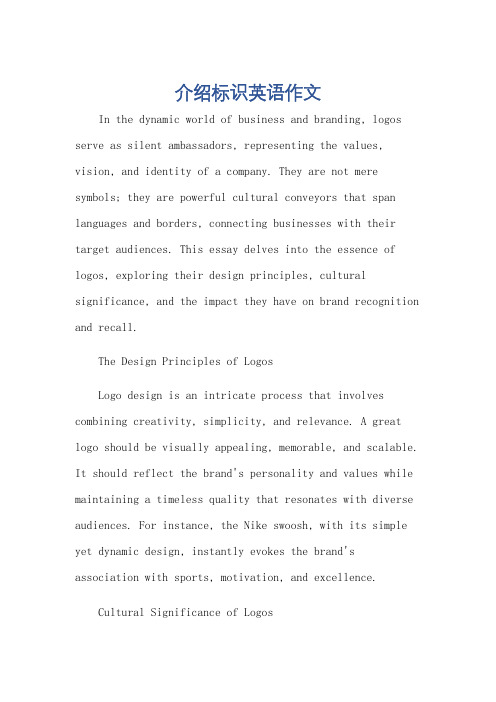
介绍标识英语作文In the dynamic world of business and branding, logos serve as silent ambassadors, representing the values, vision, and identity of a company. They are not mere symbols; they are powerful cultural conveyors that span languages and borders, connecting businesses with their target audiences. This essay delves into the essence of logos, exploring their design principles, cultural significance, and the impact they have on brand recognition and recall.The Design Principles of LogosLogo design is an intricate process that involves combining creativity, simplicity, and relevance. A great logo should be visually appealing, memorable, and scalable. It should reflect the brand's personality and values while maintaining a timeless quality that resonates with diverse audiences. For instance, the Nike swoosh, with its simple yet dynamic design, instantly evokes the brand's association with sports, motivation, and excellence.Cultural Significance of LogosLogos are not just visual representations; they are cultural reflections. They often embody the traditions, values, and aspirations of a society or region. For instance, the red and gold colors of the Chinese flag are deeply rooted in the country's history and culture, symbolizing prosperity, luck, and imperial power. Therefore, when designing a logo, it's crucial to consider thecultural context and ensure that it resonates with thetarget audience.Impact on Brand Recognition and RecallA logo is often the first point of contact between a brand and its customers. It plays a pivotal role in brand recognition and recall. A strong logo helps establish a unique identity for a brand, making it distinguishable from competitors. It acts as a visual cue that triggers brand associations and memories in consumers' minds. For instance, the Apple logo instantly evokes thoughts of innovation, simplicity, and luxury.In conclusion, logos are powerful visual tools thatplay a crucial role in branding. They are not just symbols; they are extensions of a brand's identity, values, andaspirations. By adhering to design principles, considering cultural significance, and focusing on brand recognition and recall, companies can create logos that resonate with their target audiences and create lasting impressions.**标识的本质:跨文化探索**在商业和品牌化的动态世界中,标识作为静默的大使,代表着公司的价值观、愿景和身份。
英语作文中关于上市公司的名字
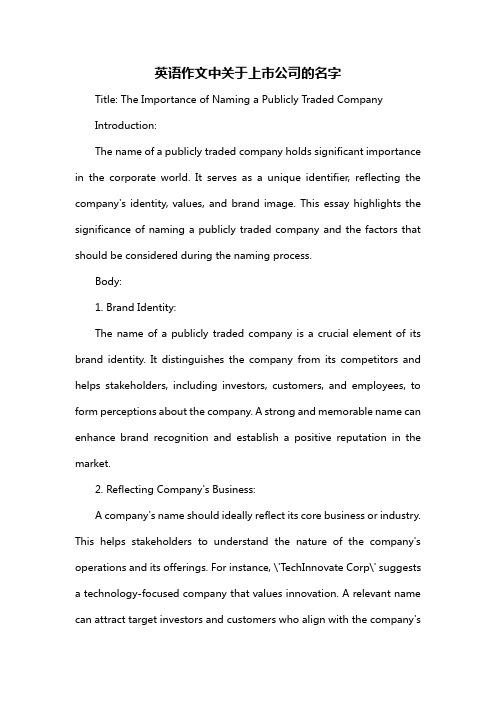
英语作文中关于上市公司的名字Title: The Importance of Naming a Publicly Traded CompanyIntroduction:The name of a publicly traded company holds significant importance in the corporate world. It serves as a unique identifier, reflecting the company's identity, values, and brand image. This essay highlights the significance of naming a publicly traded company and the factors that should be considered during the naming process.Body:1. Brand Identity:The name of a publicly traded company is a crucial element of its brand identity. It distinguishes the company from its competitors and helps stakeholders, including investors, customers, and employees, to form perceptions about the company. A strong and memorable name can enhance brand recognition and establish a positive reputation in the market.2. Reflecting Company's Business:A company's name should ideally reflect its core business or industry. This helps stakeholders to understand the nature of the company's operations and its offerings. For instance, \'TechInnovate Corp\' suggests a technology-focused company that values innovation. A relevant name can attract target investors and customers who align with the company'sbusiness interests.3. Marketability and International Considerations:When naming a publicly traded company, it is essential to consider marketability across different regions and languages. A name that sounds appealing in one culture might have negative connotations in another. Therefore, companies should choose names that are universally acceptable and easy to pronounce, ensuring global recognition and marketability.4. Legal and Regulatory Compliance:Publicly traded companies must adhere to specific legal and regulatory requirements. The chosen name should not infringe on any existing trademarks or intellectual property rights. Additionally, it should comply with the stock exchange's listing guidelines and the company's legal structure. Conducting a thorough legal search and obtaining necessary approvals is crucial before finalizing the company's name.5. Memorable and Distinctive:A successful company name should be memorable and distinctive. It should stand out from competitors and resonate with stakeholders. Unique names are easier to remember, which can contribute to increased brand awareness and customer loyalty. Avoiding overly complex or lengthy names can help in maintaining simplicity and memorability.6. Scalability and Longevity:As a company grows and evolves, its name should remain relevant and adaptable. It should not limit the company to a specific product or market segment. A scalable name allows the company to expand into new industries or geographic locations without requiring a name change. Additionally, a name with longevity will withstand the test of time and avoid becoming outdated.Conclusion:The naming of a publicly traded company is a critical aspect of its branding and market presence. It should reflect the company's identity, be marketable globally, comply with legal requirements, and possess memorability and scalability. A well-chosen name can significantly contribute to the company's success and stakeholder perception, making it a valuable asset in the competitive business landscape.。
英语四级作文替换词

英语四级作文替换词The Importance of Vocabulary in English Learning。
As we all know, vocabulary is a crucial component of English learning. It is like the building blocks of a language, without which we cannot construct meaningful sentences or express our thoughts clearly. Therefore, expanding our vocabulary is essential for improving our English proficiency.Firstly, a rich vocabulary enables us to understand English texts and speeches better. When we encounter unfamiliar words, we may not grasp the meaning of the whole sentence or paragraph. However, if we have a broad vocabulary, we can infer the meaning of new words from the context and comprehend the message more easily.Secondly, a wide range of vocabulary facilitates our communication in English. When we speak or write, we need to choose the appropriate words to express our ideasaccurately and effectively. If we have a limited vocabulary, we may struggle to find the right words or resort to using vague or repetitive expressions, which can hinder our communication and cause misunderstandings.Thirdly, a diverse vocabulary enhances our languageskills and cultural awareness. English is a global language spoken by people from different countries and backgrounds. By learning new words, we can not only communicate with more people, but also gain insights into their cultures and perspectives. Moreover, a varied vocabulary enables us to express ourselves in different styles and registers, suchas formal, informal, academic, or colloquial.Therefore, it is crucial for English learners to devote time and effort to expanding their vocabulary. There are various ways to do so, such as reading extensively, memorizing word lists, practicing with flashcards or apps, and using new words in context. By doing so, we cangradually enrich our vocabulary and improve our English proficiency.。
英语词汇学基本知识点总结

英语词汇学基本知识点总结English vocabulary is the cornerstone of the language and plays a vital role in communication, writing, and reading. Understanding the essential points of English vocabulary is crucial for learners to improve their language skills and be able to effectively express themselves in various contexts. In this summary, we will explore the basic knowledge of English vocabulary, including its types, acquisition, and usage, to provide a comprehensive understanding of this fundamental aspect of the language.Types of VocabularyEnglish vocabulary can be categorized into different types based on their usage, origin, and form. The main types of vocabulary include:1. Basic Vocabulary: Basic vocabulary consists of the most common words that are essential for everyday communication. These words are commonly used in spoken and written language and are crucial for building a foundation in the language.2. Academic Vocabulary: Academic vocabulary refers to the words and phrases that are commonly used in academic settings, such as in textbooks, research papers, and lectures. These words are often more complex and specific to certain subjects or disciplines.3. Technical Vocabulary: Technical vocabulary includes specialized words and terminology used in particular fields, such as science, medicine, technology, and engineering. These words are often challenging for non-experts to understand and require specific knowledge of the subject area.4. Colloquial Vocabulary: Colloquial vocabulary consists of informal words and expressions that are commonly used in everyday conversation and informal writing. These words may vary from region to region and often reflect the local dialect and cultural influences.5. Idiomatic Vocabulary: Idiomatic vocabulary refers to expressions and phrases that have a figurative meaning different from the literal interpretation of the words. These expressions are commonly used in spoken language and may pose challenges for non-native speakers.6. Loanwords: Loanwords are words that are adopted from other languages and incorporated into English. These words often retain their original form and meaning, adding diversity to the English vocabulary.Acquisition of VocabularyThe process of acquiring vocabulary involves various strategies and techniques to enhance one's word knowledge and usage. The following are some essential methods for vocabulary acquisition:1. Reading: Reading is one of the most effective ways to acquire new vocabulary. Exposure to a wide range of written materials, including books, articles, and newspapers, allows learners to encounter new words in context and understand their usage.2. Contextual Learning: Understanding the context in which a word is used helps learners grasp its meaning and usage more effectively. Contextual learning involves interpreting words and phrases based on the surrounding text and extracting their meaning from the overall context.3. Mnemonics: Mnemonics are memory aids that help learners remember and retain new vocabulary. Techniques such as creating associations, visualization, and using mnemonic devices can assist in memorizing and recalling words more easily.4. Vocabulary Apps and Tools: Technology-based resources, such as vocabulary apps and online tools, provide interactive and engaging platforms for learners to expand their word knowledge. These resources often offer word games, quizzes, and flashcards to reinforce vocabulary acquisition.5. Word Analysis: Breaking down words into their component parts, such as prefixes, suffixes, and roots, helps learners understand the structure and meaning of new vocabulary. This approach is especially useful for deciphering unfamiliar words and inferring their definitions.6. Vocabulary Expansion: Actively seeking out new words and making a conscious effort to expand one's vocabulary through exploration of various sources, such as dictionaries, thesauruses, and word lists, is essential for continuous language development.7. Vocabulary Practice: Regular practice and reinforcement of vocabulary through activities such as writing, speaking, and using the words in different contexts contribute to the retention and application of new vocabulary.Usage of VocabularyEffective use of vocabulary is crucial for clear and impactful communication in both spoken and written forms. The following are some key aspects of vocabulary usage:1. Word Choice: Selecting the appropriate words for expressing ideas and conveying meaning is essential for effective communication. Understanding the nuances of words and their connotations enables speakers and writers to choose the most suitable vocabulary fora given context.2. Register and Style: Adapting vocabulary to the appropriate register and style is important for communicating with different audiences and in diverse settings. Adjusting language choices based on formality, audience, and purpose enhances the clarity and effectiveness of communication.3. Collocation and Phraseology: Understanding the collocation of words and phrases, as well as familiarizing oneself with common idiomatic expressions, contributes to natural and fluent language use. Recognizing and using collocations and idiomatic language enhances the authenticity and fluency of communication.4. Vocabulary Expansion: Continuously expanding one's vocabulary through exposure to diverse texts, contexts, and sources enriches language proficiency and enables the use of more varied and precise vocabulary.5. Vocabulary Development: Engaging in activities that promote vocabulary development, such as reading, writing, and participating in discussions, contributes to the ongoing enhancement of language skills and the refinement of vocabulary use.ConclusionEnglish vocabulary is a multifaceted aspect of language learning that encompasses various types, acquisition methods, and usage strategies. Understanding the fundamental aspects of English vocabulary is crucial for learners to build a strong vocabulary foundation, expand their word knowledge, and effectively communicate in diverse contexts. By grasping the essential knowledge points of English vocabulary, learners can enhance their language skills and develop proficiency in expressing themselves with precision and clarity.。
英语高考必考知识点

英语高考必考知识点1. Diction and vocabulary: The appropriate use of words and a wide range of vocabulary.2. Grammar: Correct usage of different grammatical structures, tenses, and sentence patterns.3. Reading comprehension: The ability to understand and analyze different types of texts, including fiction, non-fiction, and academic passages.4. Writing skills: The ability to write well-structured essays, letters, and reports using cohesive devices and appropriate language.5. Listening comprehension: The ability to understand and interpret spoken English in various contexts, including conversations, interviews, and lectures.6. Speaking skills: The ability to express oneself fluently and coherently in English through engaging in conversations, giving presentations, and participating in discussions.7. Literature: Knowledge and understanding of selected literary works, including their themes, characters, and literary techniques.8. Idioms and figurative language: Recognizing and understanding the meaning of idioms, proverbs, and figurative language used in English.9. Information retrieval and note-taking: The ability to locate and extract relevant information from different sources, such as articles, books, and online materials, and taking effective notes.10. Cultural knowledge: Familiarity with aspects of English-speaking countries' culture, history, traditions, and customs.。
英语四级翻译作文单词
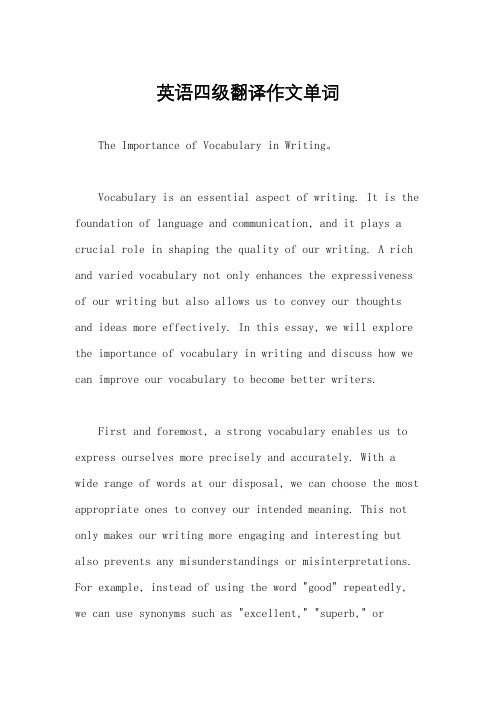
英语四级翻译作文单词The Importance of Vocabulary in Writing。
Vocabulary is an essential aspect of writing. It is the foundation of language and communication, and it plays a crucial role in shaping the quality of our writing. A rich and varied vocabulary not only enhances the expressiveness of our writing but also allows us to convey our thoughts and ideas more effectively. In this essay, we will explore the importance of vocabulary in writing and discuss how we can improve our vocabulary to become better writers.First and foremost, a strong vocabulary enables us to express ourselves more precisely and accurately. With a wide range of words at our disposal, we can choose the most appropriate ones to convey our intended meaning. This not only makes our writing more engaging and interesting but also prevents any misunderstandings or misinterpretations. For example, instead of using the word "good" repeatedly, we can use synonyms such as "excellent," "superb," or"outstanding" to add depth and nuance to our writing.Furthermore, a rich vocabulary allows us to capture the attention of our readers and keep them engaged. When we use vivid and descriptive words, we create a more vivid and immersive experience for our audience. This not only makes our writing more enjoyable to read but also helps to create a lasting impression. For instance, instead of saying "the sunset was beautiful," we can use more descriptive language such as "the sunset painted the sky with a breathtaking palette of warm hues, casting a golden glow over the horizon."In addition, a varied vocabulary enables us to convey our thoughts and ideas more effectively. Different words carry different connotations and shades of meaning, and by choosing the right words, we can express our ideas more precisely and eloquently. This allows us to communicate our message with clarity and impact, making our writing more persuasive and compelling. For example, instead of saying "I was very happy," we can use more specific language such as "I was elated," "ecstatic," or "overjoyed" to convey theintensity of our emotions.Moreover, a strong vocabulary is essential for expanding our knowledge and understanding of the world. When we encounter new words, we are exposed to new concepts, ideas, and perspectives. This broadens our horizons and enriches our understanding of the world around us. Additionally, a broad vocabulary allows us to engage with a wider range of literature and media, enabling us to appreciate and analyze complex texts more effectively.In conclusion, vocabulary plays a crucial role in shaping the quality of our writing. A rich and varied vocabulary enables us to express ourselves more precisely and accurately, capture the attention of our readers,convey our thoughts and ideas more effectively, and expand our knowledge and understanding of the world. Therefore, it is important for us to continuously expand and improve our vocabulary in order to become better writers. By reading widely, learning new words, and practicing using them inour writing, we can enhance the expressiveness and impactof our writing, and ultimately become more effective communicators.。
英语考级词汇量
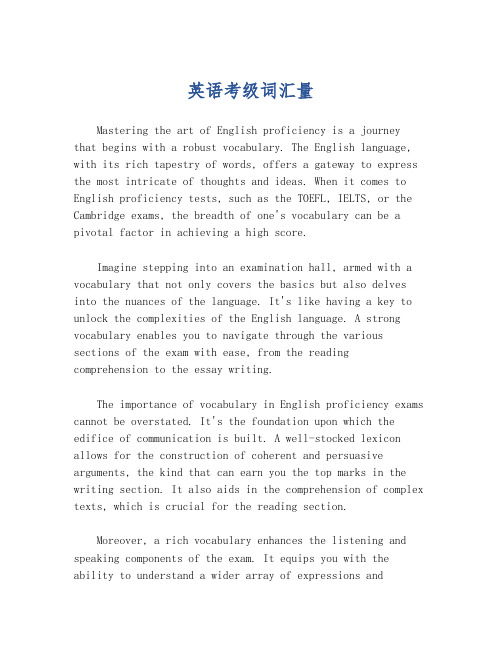
英语考级词汇量Mastering the art of English proficiency is a journeythat begins with a robust vocabulary. The English language, with its rich tapestry of words, offers a gateway to express the most intricate of thoughts and ideas. When it comes to English proficiency tests, such as the TOEFL, IELTS, or the Cambridge exams, the breadth of one's vocabulary can be a pivotal factor in achieving a high score.Imagine stepping into an examination hall, armed with a vocabulary that not only covers the basics but also delves into the nuances of the language. It's like having a key to unlock the complexities of the English language. A strong vocabulary enables you to navigate through the various sections of the exam with ease, from the reading comprehension to the essay writing.The importance of vocabulary in English proficiency exams cannot be overstated. It's the foundation upon which the edifice of communication is built. A well-stocked lexicon allows for the construction of coherent and persuasive arguments, the kind that can earn you the top marks in the writing section. It also aids in the comprehension of complex texts, which is crucial for the reading section.Moreover, a rich vocabulary enhances the listening and speaking components of the exam. It equips you with theability to understand a wider array of expressions andidiomatic language, often encountered in spoken English. When it comes to speaking, a diverse vocabulary allows for more nuanced responses, showcasing your linguistic prowess.To build this essential skill, one must immerse themselves in the language. Reading a variety of English texts, from literature to newspapers, can significantly expand your vocabulary. Engaging in conversations with native speakers, watching English-language films, and using flashcards for memorization are also effective strategies.In conclusion, the journey to English proficiency is one that requires dedication and a commitment to expanding one's vocabulary. It's not just about passing an exam; it's about embracing a language that can open doors to a world of opportunities and global communication. So, embark on this enriching voyage, and let your vocabulary be your guide to success in English proficiency tests and beyond.。
- 1、下载文档前请自行甄别文档内容的完整性,平台不提供额外的编辑、内容补充、找答案等附加服务。
- 2、"仅部分预览"的文档,不可在线预览部分如存在完整性等问题,可反馈申请退款(可完整预览的文档不适用该条件!)。
- 3、如文档侵犯您的权益,请联系客服反馈,我们会尽快为您处理(人工客服工作时间:9:00-18:30)。
Figure 1. A vocabulary tree with branch factor three and only two levels for illustration purposes. A large number of elliptical regions are extracted from the image and warped to canonical positions. A descriptor vector is computed for each region. The descriptor vector is then hierarchically quantized by the vocabulary tree. In the first quantization layer, the descriptor is assigned to the closest of the three green centers. In the second layer, it is assigned to the closest of the three blue descendants to the green center. With each node in the vocabulary tree there is an associated inverted file with references to the images containing an instance of that node. The images in the database are scored hierarchically using the inverted files at multiple levels of the vocabulary tree.
Scalable Recognition with a Vocabulary Tree
David Nist´ er and Henrik Stew´ enius Center for Visualization and Virtual Environments Department of Computer Science, University of Kentucky
2. h and its Relation to Previous Work
Our work is largely inspired by Sivic and Zisserman [17]. They perform retrieval of shots from a movie using a text retrieval approach. Descriptors extracted from local affine invariant regions are quantized into visual words, which are defined by k -means performed on the descriptor vectors from a number of training frames. The collection of visual words are used in Term Frequency Inverse Document Frequency (TF-IDF) scoring of the relevance of an image to the query. The scoring is accomplished using inverted files. We propose a hierarchical TF-IDF scoring using hierarchically defined visual words that form a vocabulary tree. This allows much more efficient lookup of visual words, which enables the use of a larger vocabulary, which is shown to result in a significant improvement of retrieval quality. In particular, we show high quality retrieval results without any consideration of the geometric layout of visual words within the frame, while [17] reports that the geometric layout is crucial for retrieval quality, which we also find to be true when using a smaller vocabulary. We will concentrate on showing the quality of the pre-geometry stage of retrieval, which we believe is important in order to scale up to large databases. The recognition quality is evaluated through retrieval on a database with ground truth consisting of known groups of images of the same object or location, but under different viewpoint, rotation, scale and lighting conditions. This evaluation shows that the vocabulary tree allows us to achieve significantly better than previous methods, both in terms of quality and efficiency. The use of a larger vocabulary also unleashes the true power of the inverted file approach by decreasing the fraction of images in the database that have to be explicitly considered. In [17], a vocabulary with on the order of 10000 visual words are used. With on the order of 1000 visual words per frame, this means that approximately a tenth of the database is traversed during a query, even if the occupancy of visual words in the database is uniformly distributed. We show that better retrieval quality is obtained with a larger vocabulary, even as large as a vocabulary tree with 16 million leaf nodes. With this size of vocabulary, several orders of magnitude less
represent an object with descriptors extracted from these local regions [1, 2, 8, 11, 15, 16, 18]. The strength of this class of algorithms is natural robustness against occlusion and background clutter. The most important contribution of this paper is an indexing mechanism that enables extremely efficient retrieval. In the current implementation of the proposed scheme, feature extraction on a 640 × 480 video frame takes around 0.2 seconds and the database query takes 25ms on a database with 50000 images.
/∼dnister/ /∼stewe/
Abstract
A recognition scheme that scales efficiently to a large number of objects is presented. The efficiency and quality is exhibited in a live demonstration that recognizes CD-covers from a database of 40000 images of popular music CD’s. The scheme builds upon popular techniques of indexing descriptors extracted from local regions, and is robust to background clutter and occlusion. The local region descriptors are hierarchically quantized in a vocabulary tree. The vocabulary tree allows a larger and more discriminatory vocabulary to be used efficiently, which we show experimentally leads to a dramatic improvement in retrieval quality. The most significant property of the scheme is that the tree directly defines the quantization. The quantization and the indexing are therefore fully integrated, essentially being one and the same. The recognition quality is evaluated through retrieval on a database with ground truth, showing the power of the vocabulary tree approach, going as high as 1 million images.
